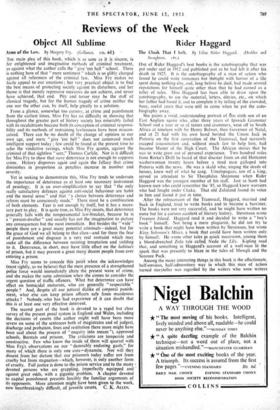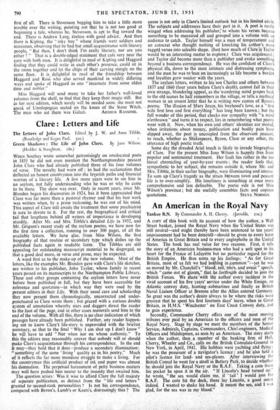Rider Haggard
ONE of Rider Haggard's best books is the autobiography that was put under seal in 1912 and published just as he had left it after his death in 1925. It is the autobiography of a man of action who found he could %%rite romances but thought with horror of a life spent doing nothing else, and, long before he died, had made several reputations for himself quite other than that he had earned as a teller of tales. Miss Haggard has been able to draw upon the autobiography, to use the material, letters, diaries, etc., on which her father had based it, and to complete it by telling of the crowded, busy, useful years that were still to come when he put the auto- biography away. She paints a vivid, understanding portrait of this sixth son of an East Anglian squire who, after three years of Ipswich Grammar School and a year or so of tutors and crammers, went off to South Africa at nineteen with Sir Henry Bulwer, then Governor of Natal, and at 21 had with his own hand hoisted the Union Jack in Pretoria on the first annexation of the Transvaal, had narrowly escaped assassination and, without much law to help him, had become Master of the High Court. The African stories that he was to write grew out of personal experience. Two hundred miles from Rorke's Drift he heard of that disaster from an old Hottentot washerwoman twenty hours before a tired man galloped into Pretoria with the news. He was a skald who, singing the deeds of heroes, knew well of what he sang. Umslopogaas, son of a king, served as attendant to Sir Theophilus Shepstone when Rider Haggard was the youngest member of his staff. Just as Scott had known men who could remember the '45, so Haggard knew warriors who had fought under Chaka. That old Zululand found its voice in him and found it just in time.
After the retrocession of the Transvaal, Haggard, married and back in England, tried to write books and to become a barrister. The books were not very successful, and he might have written no more but for a curious accident of literary history. Stevenson wrote Treasure Island. Haggard read it and decided to write a " boy's book " himself. Not being a mere plagiarist, he did not try to write a book that might have been written by Stevenson, but wrote King Solomon's Mines, a book that could have been written only by himself. He wrote other tales in quick succession, among them a blood-drenched Zulu tale called, Nada the Lily. Kipling read that, and something in Haggard's account of a wolf-man lit the spark that was presently to blaze in the tales of Mowgli and the ,Seeonee Pack.
Among the many interesting things in this book is the affectionate, half-envious, half-admonitory way in which this man of action turned storyteller was regarded by the writers who were writers first of all. There is Stevenson begging him to take a little more trouble over the writing, pointing out that he is not too good at beginning a tale, whereas he, Stevenson, is apt to flag toward the end. There is Andrew Lang, tireless with good advice., And then there is Kipling. the " inky boy " whose friends were soldiers and statesmen, observing that he had but small acquaintance with literary people, " But then, I don't think I'm really literary, nor are you either ! " That is a double-edged statement that cuts very near the core with both men. It is delightful to read of Kipling and Haggard finding that they could write in each other's presence, could sit in the room together and let the chips of their carving mingle on the same floor. It is delightful to read of the friendship- between Haggard and Ross who also served mankind in widely differing ways and spoke of Haggard as one " incarnate from some olden time and nobler."
Miss Haggard will send many to take her father's well-loved volumes from the shelf, to find that they keep their magic still. But in her next edition, which surely will be needed soon, she must not speak of Umslopogaas seated on the knees of the Stone Witch.
The man who sat there was Galazi. ARTHUR RANSOME.



































 Previous page
Previous page